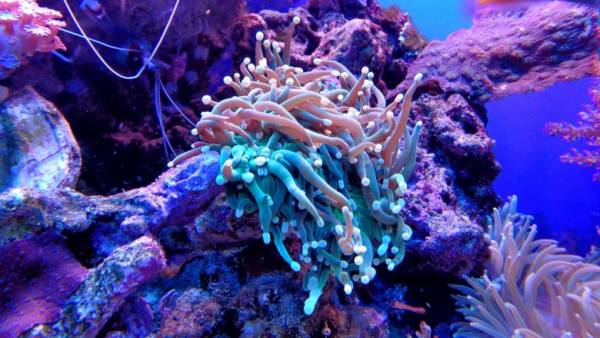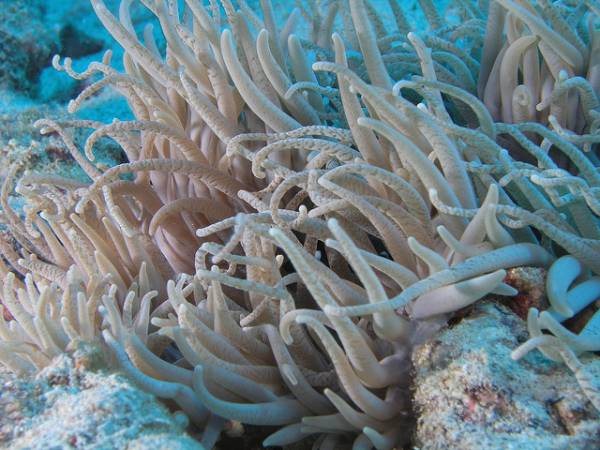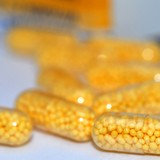Sorry to health
Somewhere far away, on the seabed, live venomous invertebrates — sea anemones. They never met with the man, but this did not prevent them to create toxins acting on our cells better than many known drugs. “Attic” has asked head of the laboratory of molecular and cellular biology, First Moscow state medical University named after I. M. Sechenov Yaroslav Andreev that can be extracted from venoms of animals as the prey are then applied, and why “natural” drugs on the market not so much.

— Let’s start the conversation at the end. Suppose you found an animal and identified the toxin. For example, it has an analgesic effect (in June Andreev and co-authors published an article about the discovery of a new toxin-analgesic — approx. ed.). How it will work?
— It is decided at the time of search of the toxin. As now constructed a standard search engine? You are creating a test system for a specific task. You source know, for example, the receptor or the enzyme involved in the perception or the transmission of pain. You are doing such a system in which you see does this stuff with this enzyme or receptor, and what it’s doing to him, inhibits or activates.
News the Texas Resident was bitten by severed snake head. He barely survived
the Texas Resident was bitten by severed snake head. He barely survived
We are mainly looking for substances that act on receptors involved in the perception of pain. We searched all poisonous animals, which can find, take every poison, adding it to the cells which have the receptor and see, there was something or not. If there were, we allocated the active component [of the poison], obtain its recombinant analog (that is, forcing the bacterial cells to produce approx. ed.) to further study its effect completely. And only when we looked at all the receptor — and there are unexpected moments! — then check on animals. The animals were tested in the experiment, which is activated only the desired receptor.
For example, the TRPV1 receptor is responsible for pain perception and at the same time the perception of capsaicin, the burning substance pepper. If you enter capsaicin in the paw of the mouse, you activate the receptor — mouse [getting] hurt and it shows, licking his paw. If we pre-enter the test substance and the effect of the pain will weaken, so we have a substance that blocks pain receptor not only in vitro but also in vivo.
This is very important because in the case when pharmacological companies are searching for substances in the same way in chemical libraries, there is a huge problem.
It turned out that not very difficult to find a substance that acts on a receptor in the chemical library, but when you enter it animal substance or destroyed in the liver, or settles, or something else happens to him.
It doesn’t work as expected. In the event of natural peptide toxins which are often of no effect because they were created by nature in order to work in vivo, not in vitro.
— What was unexpected for you?
— Unexpected moments are when the effect, the alleged studies “in vitro”, has the opposite animals. Fortunately, all of this often can not find a reasonable explanation, and confirm it experimentally.
News the Paradox of the Japanese diet: healthy, but dangerous
the Paradox of the Japanese diet: healthy, but dangerous
It is known that in our body there are some system-fuses. Thanks to them we can’t feel more pain than hell. Accordingly, there is a system that turns off the pain cascade once it is activated too long. This, too, can play: you can send the signal the system that a neuron stimulated.
This effect is a long-known and well-studied on the pain receptors agonists such as capsaicin already mentioned. What was unexpected in this effect: in the venom of sea anemones we found no agonists (substances that activate receptors — approx. ed.) a substance that increases the response of TRPA1 receptor on the effect of the agonist. Before that analgesic effects were shown only on the agonist of pain receptors: you give him the animal, he still hurt first, and then some days it feels no pain. And the same principle works we have discovered peptides: they increase the response of the receptor to agonist, the receptor together with the neuron stops responding, and it turns out the anesthesia.
 Sea anemone Heteractis crispa, from where Andreev and his colleagues isolated the toxin analgesic.
Sea anemone Heteractis crispa, from where Andreev and his colleagues isolated the toxin analgesic.
Thus, with the introduction of the peptides of mouse feels no pain, and the peptides act on the receptor, it sends a signal that there was an excessive activation of the neuron, and the neuron ceases to respond to external signals. And the mouse feels much less pain at introduction receptor agonist or inflammation.
— If viewed from the side, the situation looks rather strange: there is a sea anemone that had never met man, but somewhere in her is a substance that is ideal to our receptor. How did this happen?
News , the milk of the platypus kills Supermicro
, the milk of the platypus kills Supermicro
— As you probably know, all beings are at some point descended from a common ancestor. We have a lot of homologous (have a common origin — approx. ed.) institutions, and they are in the process of evolution began to be responsible for different things. Channels such as TRPA1 or TRPV1 (pain receptors to study Andreev — approx. ed.) have sea anemone and those animals on which they prey. Only there can they be responsible for other functions. Therefore, there are no guarantees, something the substance that acts in mice and humans as an analgesic, will act as crabs or fish. Maybe it will be these crabs to paralyze, disorient or give them a feeling of euphoria.
But in the case of peptides acting on TRPA1 I have one idea. It is known that sea anemones are fighting with each other on the seabed for a place, more comfortable life. How do sea anemones inject venom into the victim? They have special stinging cells, as in the nettle, and when someone else applies to such cells, it ejected the flagellum, which penetrates the skin and injects poison. And because of the perception that touch the sea anemone meets homolog of TRPA1. Accordingly, an anemone, which has a toxin that blocks TRPA1 or Vice versa activating it, could disarm the other anemone species.
Thus, for each of the toxin most likely there is some kind of a function. These toxins need these animals, they give them an evolutionary advantage over others. But anemones are not often met and toxins are not as anemones are used. During the download an error has occurred.Fight sea anemone
During the download an error has occurred.Fight sea anemone
— What group of animals do you think are the most promising for the search of toxins? Why did you choose anemone?
News Nitrate hysteria. Why you should not panic fear of nitrates
Nitrate hysteria. Why you should not panic fear of nitrates
— In fact, no matter where to look. You can search not only in poisonous animals, you can search and in medicinal plants. But why chose a poisonous animal? Because they have the task to act for a victim or the enemy, and they have developed a huge number of molecules which have to act at all. Because single peptide (“necobelac”, a short chain of amino acids — approx. ed.), which acts on the crabs, the anemone will not work — then you need to have a lot of different ways. In each individual anemone, of course, impossible to find peptides that act on all interesting targets. But if you take a sufficient number of anemones, snakes, spiders, you can find a peptide acting on the receptor you are interested in. Our experience shows that sorting through 10-20 poisons and extracts, almost every receptor that it is possible to find.
— That is, we cannot say that some groups of animals more promising than others? Those who are evolutionary closer to humans have more similar receptor, and therefore the toxins will be more efficient?
— It is absolutely unpredictable. This is due to millions of years of evolution each organism, and we don’t know what happened there. Therefore, we cannot say that a snake, for example, is closer to man than anemones, so they better make analgesics.
Do snakes prey on mammals, so they will be better to kill mammals, and anemones are better able to kill fish and crabs.
But about the more subtle effects of [this] to assume, since we are not the main active component and the side component of evolution, which has some intermediate effect, such as analgesic.
News Treatment of animals: 4 popular ways
Treatment of animals: 4 popular ways
Organisms that you work for, a person relatively unfamiliar. Does this mean that the favorite objects of traditional medicine — snakes, leeches, bees already studied up and down and there is nothing more to find?
— Yes, they are pretty studied in this field often have nothing to look for. But we, in fact, have the serpent, we tested our receptor of all snakes, but unfortunately found nothing. Just the snake is focused on mammals, and they target them to paralyze or kill. If we were looking for toxins that kill mammals, I think a snake would around anemone.
What is more effective: to look for natural toxins or simulate them on the computer bioinformatics methods?
Besides the fact that we need to conduct simulation, we need therefore to check the results “in vitro”. And the probability that the model is built correctly, today is not very high. Despite the fact that modeling is leaps and bounds ahead, still all the results should be checked and in vitro and on animals. So far, more than 90% of the models do not take into account a lot of things.
This is due to the fact that the receptors are large, and the computing power we have not yet adequate to calculate the movement of each area of the molecule fails.
Of course, if you know the structure and possess a huge and boundless capacity modeling, it is theoretically possible to create the perfect molecule, but is far from it. At the same time, on the side of venomous animals millions of years of evolution, and they can offer us ready-made solutions. And to take what is already prepared is easier than to model from beginning to end. Now there are several drugs on the basis of peptide toxins, but for some reason the pharmaceutical companies this approach is no longer interested in.
— Do you have any idea why this is happening? Because the model is cheaper or easier?
News tarantula Venom may be an effective analgesic
tarantula Venom may be an effective analgesic
I’m not very clear, because in the animal models, of course, the peptides are active (i.e. are more effective — approx. ed.). Maybe in our region it is not very good moves, because there are low molecular weight substances which, in varying degrees, effective. Any pharmaceutical companies more profitable to produce cheap drugs, than to create something new, even if it will be a hundred times more efficient. But at some point, I think everything is slowly moving in the direction of such biological drugs, because of side effects from them, of course, less.
— Let’s talk about the possible applications of these toxins. The first thought that comes to my mind: is it possible to use, for example, for targeted delivery of drugs into cells with certain proteins?
— Targeted delivery, of course, of interest to many, as it will solve many problems faced by modern pharmacology. But it works only when the locomotive is pulling the train, not when the cars are on the first slide, roll and leave to another place. It usually happens when talking about targeted delivery: let’s sew for antibody a huge something, for example, liposome (membrane vesicle with substances — approx. ed.) antibody and drag it to the target. But no, that never happens, the liposome will be in contact with the first cell or reach the liver and remain there forever, and the antibody is anywhere its not dragged.
If you need to deliver targeted something small can be a peptide toxin will be good for this, if you want to deliver a huge liposome a lot of drugs, most likely, will not work. So effective that the cure had brought itself.
If it itself does not deliver, then get it to go where it is needed, is quite difficult. In modern medicine this is accomplished this: enter a large enough dose that the active substance is evenly distributed throughout the body and have time to act on the organ, before being destroyed in liver enzymes or to be derived by the kidneys.
— Is there any other possibility of using these toxins?
News Scammers in medicine: to recognize and neutralize
Scammers in medicine: to recognize and neutralize
— Our colleagues from other countries are exploring different options, in which you can use toxins. For example, our Australian colleagues once upon a time was isolated from anemone potassium channel blocker, but not all, of a certain type, and these channels are responsible for the development of autoimmune diseases. It has a lot of years of study, reached the second stage of clinical trials, and it seems that the concept works. But just for example, unfortunately, shows the negative attitude of pharmaceutical companies for peptides. If they had a low molecular weight substance which has that effect, it would have with torn hands, and they are on their own for ten years, carried out these clinical studies, and they are very difficult, despite excellent results. The fact that the peptide is more complicated to produce. While on the other hand, antibodies produce, and everything is in order. But produce antibodies for the treatment of previously incurable diseases such as cancer, and therefore they are sold for any money. And other drugs, unfortunately, pharmaceutical companies are not willing to invest money, and are willing to medicate a century ago.
— In one interview you talked about the possible use of toxins like antibiotics. Is there some term?
— This prospect has been discussed for a very long time, although it seems to me that while on antibiotics based on peptides, to speak still early. It is clear that the idea is excellent: some kind of bacterium causes the disease in humans and thus resistant to existing antibiotics, and of plants, anemone and other organisms have protective peptides that kill the bacteria. Let’s take these protective peptides and will introduce them to and the bacteria will die. But, unfortunately, these protective peptides or represent cytolytic (that is, destroy cell membranes, including human cells — approx. ed.) or very large. But if the peptide is very large, then it develops an immune response, and it is unknown which is worse bacteria or an allergic reaction caused by this peptide.
And strategy of many plants tricky: peptide very much, they all act on different areas of vital activity of bacteria. If you take any plant extract, and study its effect on bacteria, it dies.
But when you begin to isolate the active components, you have this antimicrobial activity lose, because there is no one powerful component, but there are a lot of weak. But to introduce a lot of weak components is even worse, it’s definitely the way to development of allergic reactions. Moreover, to produce and certify a number of components are much more expensive than one.
— That is, in the near future we of antibiotics from anemones to be expected?
— Our Norwegian colleagues, from whom we took the poison of anemones. The chances of any there, but it is an element of luck. Need to find a highly active small peptide, which is not Catalytica in respect of human cells, or acts by some other mechanism. At any time, researchers can find such a peptide, and it will be a breakthrough. It can happen in one day. Today someone might say that it is futile, and tomorrow this peptide is found.